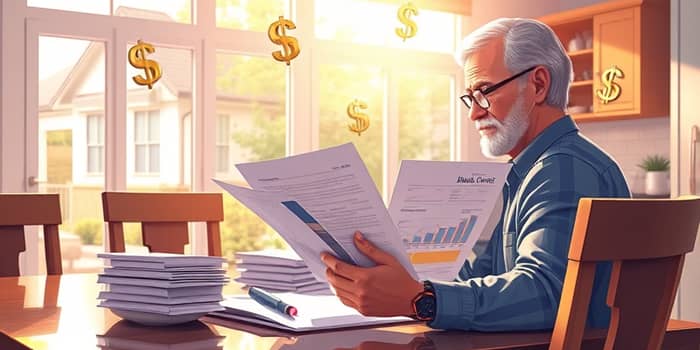Refinancing is a powerful financial strategy that can transform the terms of your loan, reduce your interest payments, and free up cash flow. Whether you have a mortgage, auto loan, personal loan, or student debt, understanding how refinancing works is the first step toward long-term savings and financial stability.
Understanding Refinancing Basics
At its core, refinancing involves replacing an existing loan with a new loan that offers improved terms. The primary goals are to secure a lower interest rate, adjust the loan term, or access equity in your property. By doing so, borrowers can often reduce their monthly obligations or shorten the payoff period.
Unlock significant cost savings over time by negotiating favorable rate-and-term changes or switching from an adjustable-rate mortgage to a fixed-rate structure. Every dollar saved in interest is money that can be redirected toward savings, investments, or paying down other debts.
Types of Refinancing Loans
- Rate-and-term refinance: Focuses on lowering your interest rate or changing the term length without accessing equity.
- Cash-out refinance: Lets you borrow more than your current balance and receive the difference in cash for large expenses or debt consolidation.
- Cash-in refinance: Requires a lump-sum payment to reduce the principal, improving your loan-to-value ratio and potentially qualifying for better rates.
Major Benefits of Refinancing
Lower your monthly payments significantly by refinancing when market rates drop. A reduction of even one percentage point can translate to hundreds of dollars saved each month.
Choosing a shorter loan term—such as moving from a 30-year mortgage to a 15-year mortgage—allows you to shorten your loan term effectively while building equity faster. Although monthly payments may rise slightly, the interest savings over the life of the loan can be substantial.
For those with adjustable-rate mortgages, refinancing into a fixed-rate loan can avoid unexpected future rate hikes and bring predictable, stable payments that fit within your budget.
With a cash-out refinance, you can access home equity as cash to fund home improvements, cover educational expenses, or consolidate high-interest credit card debt, often at a rate far lower than unsecured borrowing.
Illustrative Example: Real Savings Calculations
Consider a homeowner who purchased a $400,000 property with a 10% down payment, securing a 30-year mortgage at 7% interest. Six years in, the remaining balance stands at $333,690, and $146,135 has been paid in interest.
By refinancing the outstanding balance of $333,690 into a new 30-year loan at 5%, the borrower would pay $311,185 in interest over the full term. Compared to the $502,232 total interest on the original loan, this move reclaim thousands in potential interest, saving nearly $45,000.
Even if the borrower remains on the new loan for just ten years before selling or refinancing again, the savings on monthly payments and accrued interest remain compelling evidence of the advantages of refinancing wisely.
Potential Drawbacks and Risks
- Closing costs and fees: Typically range from 2% to 5% of the loan amount, including appraisal and origination fees.
- Extended loan term: Rolling a late-stage mortgage into a fresh 30-year term can increase total interest paid, despite lower monthly dues.
- Risk of over-borrowing: Cash-out refinancing elevates debt levels; home value fluctuations can intensify financial strain.
- Credit score impact: Hard credit inquiries and account adjustments may temporarily lower your credit score.
Step-by-Step Guide to Refinancing Your Loan
- Review your current loan’s interest rate, balance, and remaining term.
- Research market rates and refine your refinancing objectives.
- Calculate projected savings and total costs using online mortgage calculators.
- Request quotes from multiple lenders to compare offers and negotiate terms.
- Submit your application, complete the appraisal, and navigate underwriting to close the new loan.
Expert Tips to Maximize Savings
Timing is crucial: aim to refinance when rates dip by at least one to two percentage points. This threshold ensures that the interest savings outweigh closing costs within a reasonable break-even period.
Always weigh the benefits of a shorter term against monthly cash flow requirements. If you can afford higher payments, a 15- or 20-year mortgage can accelerate equity buildup and minimize interest outlays.
Compare fixed and adjustable options based on your personal risk tolerance and financial timeline. In a rising-rate environment, locking in a fixed rate can be a prudent choice.
Negotiate closing costs by requesting lender credits or shopping for lower third-party fees. Even small reductions in origination or title charges add up to significant savings.
Summary of Key Points
Refinancing can be a game-changer when executed thoughtfully. By analyzing your financial goals thoroughly and selecting the right loan structure, you can unlock immediate savings, streamline debt repayment, and build a stronger foundation for your long-term financial success.
References
- https://www.investopedia.com/terms/r/refinance.asp
- https://www.nationwide.com/lc/resources/personal-finance/articles/benefits-of-refinancing-your-home-loan
- https://www.rocketmortgage.com/learn/pros-and-cons-of-refinancing
- https://www.experian.com/blogs/ask-experian/what-is-refinancing/
- https://www.quickenloans.com/learn/what-is-refinancing
- https://www.caccu.org/pros-cons-of-refinancing-your-mortgage/
- https://listerhill.com/blog/2021/05/how-refinancing-could-save-you-money
- https://www.comerica.com/insights/personal-finance/refinancing-your-mortgage-loans-101.html










